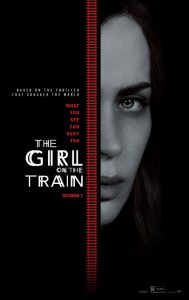
The story of “The Girl on the Train” belongs to Rachel Watson (Emily Blunt). It is not because she’s the eponymous protagonist, but because the mystery is heavily played out through her subconscious. The mystery, the how and why regarding the disappearance of Megan Hipwell (Haley Bennett), would’ve occurred without Rachel’s involvement. It’s her involvement that makes it so enthralling, as her fascination with it sends up many red flags.
The film opens with her obsession over Megan’s relationship with Scott (Luke Evans), developing fantasies of an idyllic marriage to quell her sorrow over her own failed marriage. She creates these fantasies out of quick glimpses into their home as her train barrels by. Their home is two doors down from her former home, now occupied by her ex, Tom (Justin Theroux), his new wife, Anna (Rebecca Ferguson), and their baby. She is as obsessed with them as she is with the “idyllic” couple, constantly calling Tom and stalking the house.

The disappearance of Megan distracts Rachel from her emotional breakdown. Up until this point, she existed in a constant state of inebriation, hopping on the train to Manhattan solely to drink and play spy. Megan’s disappearance gives her a new purpose, especially after she witnessed her seemingly having an affair. This affair also brings about anger, as it destroys Rachel’s perception of the perfect marriage, the only fantasy keeping her sane.
Rachel’s fascination brings upon suspicion. She was reported being seen in the area the night of the disappearance, her blackout causing her to forget her actions. She’d already been reported for stalking her ex, killing her credibility dead in its tracks. All signs point to her being the culprit. All that’s needed is evidence to back it up. She slowly recalls key elements to clear her name, but her inability to remember events correctly causes confusion amongst herself and the audience. Could she be responsible for Megan’s disappearance?

Had the story been told solely through her perspective as detailed, then “The Girl on the Train” would’ve been riveting. Instead, it cuts between three unreliable narratives, similar to the structure of “Gone Girl,” but not as effective. The reason being the other two narratives provide too much information at inopportune times. They pull the curtain back for the spectator, revealing from the outset that Megan & Scott’s relationship was anything but ideal, and that Rachel has Anna fearing for her life. The latter at least plays into Rachel’s crippled psyche without revealing much that she wouldn’t know, but it gets lost in the shuffle, only striking with maximum impact during the finale. This in turn causes the twist to lose some of its luster. Not to mention the twist is too obvious thanks to the numerous red herrings that pointed in its direction.
Those other two narratives, told by Megan and Anna, exist solely to provide red herrings. While this is serviceable in a thriller, there must be restraint to avoid overloading the senses. Too much information is given, causing said overload. I became so overwhelmed by it all that I stopped caring about the mystery, becoming more captivated by Emily Blunt’s superlative performance. When the narrative would steer away from hers, I’d lose interest, as both Megan and Anna’s travails didn’t interest me. Megan’s at least got more emotionally gripping the longer it went, but again it revealed too much, destroying Rachel’s disillusion before she even discovers it.

This is also Rachel’s story because the twist directly involves her. While the disappearance doesn’t, the reasoning behind it does. I won’t reveal how it does, but will give credit that it’s ingenious…until I started questioning its validity. The twist relies heavily on Rachel’s intoxication and memory loss, which prompted me to question just how much she’d forget. In order for the twist to work, she must lose almost all recollection of her past; had she not, she could’ve easily spilled the beans sooner. I am willing to suspend my disbelief for this to work, if only because of how strongly Emily Blunt made me believe in Rachel’s instability.
Even with that suspension of disbelief, the twist isn’t as shocking as it should be. Megan’s narrative alone helped give it away, also prompting the story to constantly skip back to fill in the missing pieces. These pieces were already put together, though, only now being shown to further drive home the point. Rachel discovering the twist was sufficient; I didn’t need to see it play out moments later.

Megan’s narrative also kills some of the suspense involved in Rachel’s investigation. When she visits Scott to break the news of the affair, she is still of the belief that he was the perfect husband. However, the cat has already been let out of the bag for the audience that he’s emotionally abusive. When the time comes for him to snap on Rachel, it’s not as unsettling as it could be since we knew it was coming. There is some credence to the fact that knowing it was coming developed good suspense, but it unfortunately doesn’t last long. I understand why the audience needed to know this information, but felt it could’ve been revealed in an alternative way. Take, for example, Rachel’s admittance as a patient of Megan’s therapist, Dr. Kamal Abdic (Édgar Ramírez). She’s infiltrating his mind by pretending to be a patient in order to get answers on his possible involvement. Why not have her discover here, by sifting through his notes, that Scott is abusive? It would give a physical manifestation of her fantasy being destroyed, as well as drumming up fear of Scott? That way, when she returns home to see him waiting for, it’s more startling for both her and the audience.
I realize my criticisms of the film are more and less criticisms of the novel in which it’s adapted from. Fair play to director Tate Taylor and screenwriter Erin Cressida Wilson for doing Paula Hawkins’ novel justice in translation. That doesn’t hinder my frustrations with the story’s structure, however, though I’m willing to admit my complaints are with Hawkins. Part of the blame does fall onto the filmmakers, however, for making both Megan and Anna’s narratives underwhelming.

I try not to rewrite stories, as that is to miss the point entirely. I fell victim to it this time, though, as I only found one narrative to be enthralling. Because of this, the other two narratives felt like nuisances. The more I thought about them, and the twist itself, the more I came to the belief that they could’ve been excised and the story still would’ve worked (give or take a few minor tweaks to effectively convey key elements). The story would’ve been better, in my opinion, as the mystery would’ve been in line with Rachel’s investigation; impaired because of her mental frailty.
Final Rating: C+
